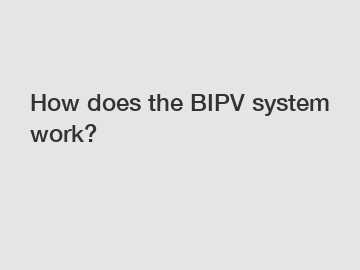How does the BIPV system work?
Harnessing Solar Power with BIPV System.
In an age where renewable energy sources are becoming increasingly important, building-integrated photovoltaics (BIPV) systems are gaining popularity as a sustainable energy solution. BIPV systems offer a dual purpose by seamlessly integrating solar panels into building materials while generating clean electricity. But how exactly does this innovative system work? Let's dive into the details of how BIPV systems harness the power of the sun to provide energy-efficient solutions for buildings.
Solar Panel Integration.

One of the key features of BIPV systems is their ability to seamlessly integrate solar panels into various building materials such as roofs, facades, and windows. Unlike traditional solar panels that are mounted on top of existing structures, BIPV systems are designed to serve as functional building components while generating electricity from sunlight. This integration not only enhances the aesthetics of the building but also maximizes the solar energy capture potential.
Energy Conversion Process.
Once the solar panels are integrated into the building structure, they start harnessing sunlight through photovoltaic cells. These cells are made of semiconductor materials, such as silicon, that convert sunlight into direct current (DC) electricity through the photovoltaic effect. As sunlight strikes the solar panels, the photons in the sunlight dislodge electrons from the atoms within the semiconductor material, creating an electric current.
Inverter Conversion.
The DC electricity generated by the solar panels needs to be converted into alternating current (AC) electricity, which is the standard form of electricity used in buildings. This conversion is done by an inverter, a device that not only converts DC to AC but also regulates the flow of electricity to match the building's energy needs. The inverter ensures that the electricity generated by the BIPV system is usable and compatible with the building's electrical systems.
Energy Distribution and Usage.
Once the electricity is converted into AC, it can be used to power the electrical appliances and systems within the building. Any excess electricity generated by the BIPV system can be stored in batteries for later use or fed back into the grid for credit through net metering programs. By utilizing the electricity generated from sunlight, buildings with BIPV systems can reduce their reliance on traditional energy sources and lower their carbon footprint.
Monitoring and Maintenance.
To ensure optimal performance and efficiency, BIPV systems require regular monitoring and maintenance. Monitoring systems are often integrated into BIPV installations to track energy production, detect any malfunctions, and optimize energy usage. Routine maintenance such as cleaning the solar panels, checking electrical connections, and inspecting the overall system is essential to prolong the lifespan of the BIPV system and maximize its energy output.
Conclusion.
Building-integrated photovoltaics (BIPV) systems offer a sustainable solution for harnessing solar power while seamlessly integrating renewable energy sources into building structures. By leveraging the power of the sun, BIPV systems generate clean electricity, reduce energy costs, and minimize the environmental impact of buildings. With advancements in technology and design, BIPV systems are paving the way for a greener future by transforming buildings into energy-efficient and self-sustaining structures.
If you are interested in incorporating a BIPV system into your building or have any questions about renewable energy solutions, feel free to contact us. Let us help you harness the power of the sun and create a more sustainable future together.
Are you interested in learning more about solar roof tiles melbourne, bipv solar roof tiles, Gain Solar company? Contact us today to secure an expert consultation!

Comments
0